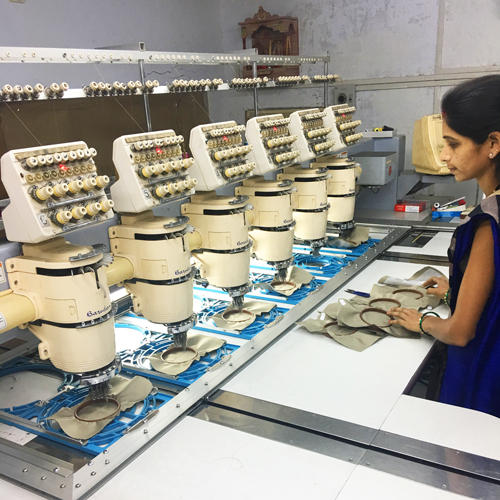We believe in transparency, sourcing locally and ethical practice. We joined the #WhoMadeMyClothes campaign as part of #FashionRevolution Week.
Traceability - #WhoMadeMyClothes
Do you know where your clothes come from?
Most of 3RD ROCK's clothing is made in Turkey, Portugal and Bangladesh. We source our fabrics locally to where our garments are made, this helps reduce our footprint. The facilities we use in India weave their own fabrics from locally grown Organic Cotton and locally recycled PET. We only work with factories that follow the Ethical Trading Initiative (ETI) base code.

Many of our woven trousers and shorts are made in Turkey, Portugal and Bangladesh. Here are a pair of our denim shorts being sampled in the Porto sampling room. We have also recently started to produce some of our Recycled light-weight trousers and shorts in the Mumbai/Thane district of India too.

Our Bra-tops and Vest are made in Lithuania and Portugal both facility that also knit their own Organic Cotton, Recycled PET and Modal fabrics.

Our Recycled leggings are made in Lithuania and Portugal, using Recycled Italian carpet fabric which we send from Italy once they have been digitally printed.

Our Luna Bar-top is being Quality Controlled in the photo above to ensure sewing quality and sizing is within acceptable tolerances.

Our solstice leggings are being produced in the photo above.
Ethical Trading Initiative (ETI) Base code basics:
- Employment is freely chosen
- Freedom of association (=Unions)
- Working conditions are safe and hygienic
- Child labour shall not be used
- Living wages are paid
- Working hours are not excessive
- No discrimination is practiced
- Regular employment is provided
- No harsh or inhumane treatment is allowed.
Indian Facility
We are working with a factory in Mumbai, India. There are 3 facilities involved in the process, a sampling studio in Mumbai, a fabric mill 1.5hr drive away in Bhiwandi, and garment factory 2.5hrs drive away in Dhanau. They are all within the district of Thane.
The main driving factor for moving our trousers/shorts production from Turkey to India this season, was because of the light weight RECYCLED fabrics available. Turkey is great for producing organic cotton but they don't make recycled PET fabrics like India. Turkey are very proud of their own textile industry so make it very difficult to use/import fabrics from other countries. The workmanship of the garments was also high in India. Unfortunately for 3RD ROCK the prices we get from India are not cheaper than Turkey, they are in fact more expensive! Shame for us, but true.

I (Jessica) have personally visited all of the Indian facility sites and seen first hand the conditions, standards and practices followed there. I have spoken to workers and asked if they would be happy to have their photos taken with me and my ‘I made your 3RD ROCK clothes’ sign. They were very happy to talk to me and share their stories and excited to be on our website and social media. The best part of my whole trip to India was talking to the people in the workforce, their smiles were infectious and their stories were very varied, but it is common for people to relocate from remote villages (like Bihar) to seek better opportunities and employment in big cities like Mumbai.
In the sampling studio it had almost exclusively male workers, as did the fabric mill, however in the garment factory the split was roughly 50/50 male to female. After asking them why this was, I now understand that this is due to the fact that once couples have children it is the mothers that stay at home to care for the children while the fathers work to support the family financially. At the garment factory the female workers either had grown up children or were not yet married with children.
The workforce are very highly skilled professionals who take pride in their work, some have worked there for over 20 years and say that they are happy there. Many of the machinists wore headphones in one ear while working to listen to music from their mobile phones. They told me it helped them concentrate and ‘get into their flow’ with the sewing. We saw first hand the health and safety standards and practices around all the facilities.




Despite some negative stigma, India is an amazing place to produce ethical products. My previous boss Katharine Hamnett (the godmother of green fashion) produced her collections there, as do many other eco and ethical brands. They are leaders in Organic cotton production and educators of organic farming practices (I have personally visited the organic cotton fields in central India and sat in on lectures given by organic farming scientists and local cotton farmers). They also have leading producers of recycled PET yarns (polyester that is made from plastic bottles collected throughout India). Like ours, many Indian factories weave the fabric themselves and make the garments too, cutting out transportation costs and emissions. You can find really great factories that comply with the ETI labour standards base code (providing a living wage) and that are powered by solar energy too. India can be an extremely great place to produce your clothing.
What actually goes into making a garment?
A lot goes into creating our garments. From coneptualisation right through to final testing. Even though we follow the same general process for our garments, there are different elements added depending on what the inspiration and intention of the item is. There's also all the wider-world considerations which can affect shipping costs & times.
Concepts, design and prototypes
We'll start by creating the product concept (Generally from Jessica's marvelous mind), which then leads to technical drawings, building the specifcation pack, and digitizing any patterns.
Once we're settled on the design, fabric and trim sourcing, we move to pattern cutting, sampling and fittings. Once we've had the first run of cuts & fittings we'll re-cut the pattern, get more samples, and run more fitting & product testing. Nothing is perfect on the first try!
Early stages of production
Once we've settled on the design, and are happy with the patterns and fabrics, we need to think about the reality of creating this garment.
First is grading the garment into size breakdowns, communicating with our garment factories, and the final round of sampling - which then helps with size set production.

Preparing the fabrics/design
Ahead of any major cutting and sewing, first we need to lab-dip colour match, calulcate shrinkage, amend the pattern master to include shrinkage.
Time to cut
Now it's time for the factory to begin production by laying & prepping the fabric for cutting, printing cutting templates, and cutting out all the fabric pieces. This may sound like a simples and quick task, but that's not always the case. For examples, our Mercury Jean is created using 27 different pieces - all of which need to be cut with extreme precision.
The details
Time to add the extras. This includes detail embroidery, printing, screen making, zip & button production, adding wash labels, stitching hanging loops, and any other sewing components to bring the final garment together.
Time to make sure it's all perfect!
We make sure all of our garments are to the highest standard. So once the garment is created, it's time for quality control. Making sure the stitching is correct and there's no clear manufacturing errors.
Wrap it all in a pretty parcel
Now the garment is hot off the press, it's time to get to packing for UK delivery.
So now we've got the folding & packaging process. This isn't just 2 folds, wack it in a bag and call it a day. As a matter of fact...no garment bags please! Our paper swing tags are added to each garment by a piece of string, and items are tied up with 3RD ROCK ribbon.
To the UK!
To make sure everything it tracked correctly, barcodes are allocated to the garments. Then it's a case of shipping from facility to the port. This comes with administration & customs fees. Then the brand new 3RD ROCK goodies are on their way from port to our UK warehouse.
Don't forget the stages before 3RD ROCK get involved too!
Fabrics & fibres don't appear out of nowhere. There's an entire process of cotton growing, cotton harvesting, fiber ginning, yarn spinning, yarn sanforising, yarn wrapping, plastic bottle collection, yarn extrusion, fabric weaving, fabric dying, and fabric QC.
The cost of a garment is not solely down to the wage you pay the person that sews the cut fabric pieces together. We make sure that our supply chain complies with the ETI labour standards base code, this ensures the workers are pair a fair living wage.


It's important to understand what's included in the full cost of a garment.
There are so many elements to clothing production, it’s an extremely sensitive and price driven industry with so many processes involved, there can be around 30+ individuals and 10+ businesses involved in producing 1 single pair of trousers, each needing to make a margin to function. Here is a list of the businesses usually involved in the product alone:
Brand (3RD ROCK) / production facility / dying house / garment printing house / YKK and other trim producers / paper printers / farmer / recycling unit / yarn producer / shipping company / shipping agent / warehouse.
3RD ROCK’s margin also needs to cater for the cost of sales too, which will involve model agencies, photography studios, web developers, content creators, trade shows, sales tours, catalogue production and printing, ambassador team, general running costs of the studio and Team wages.


